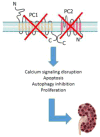Polycystin and calcium signaling in cell death and survival
- PMID: 28601384
- PMCID: PMC5701862
- DOI: 10.1016/j.ceca.2017.05.011
Polycystin and calcium signaling in cell death and survival
Abstract
Mutations in polycystin-1 (PC1) and polycystin-2 (PC2) result in a commonly occurring genetic disorder, called Autosomal Dominant Polycystic Kidney Disease (ADPKD), that is characterized by the formation and development of kidney cysts. Epithelial cells with loss-of-function of PC1 or PC2 show higher rates of proliferation and apoptosis and reduced autophagy. PC1 is a large multifunctional transmembrane protein that serves as a sensor that is usually found in complex with PC2, a calcium (Ca2+)-permeable cation channel. In addition to decreased Ca2+ signaling, several other cell fate-related pathways are de-regulated in ADPKD, including cAMP, MAPK, Wnt, JAK-STAT, Hippo, Src, and mTOR. In this review we discuss how polycystins regulate cell death and survival, highlighting the complexity of molecular cascades that are involved in ADPKD.
Keywords: ADPKD; Apoptosis; Autophagy; Calcium signaling; Polycystins; TRPP2.
Copyright © 2017 Elsevier Ltd. All rights reserved.
Conflict of interest statement
The authors state that there are no competing interests.
Figures


Similar articles
-
Structure and function of polycystins: insights into polycystic kidney disease.Nat Rev Nephrol. 2019 Jul;15(7):412-422. doi: 10.1038/s41581-019-0143-6. Nat Rev Nephrol. 2019. PMID: 30948841 Review.
-
Role of apoptosis in the development of autosomal dominant polycystic kidney disease (ADPKD).Cell Tissue Res. 2017 Jul;369(1):27-39. doi: 10.1007/s00441-017-2628-6. Epub 2017 May 30. Cell Tissue Res. 2017. PMID: 28560694 Review.
-
Interdependent Regulation of Polycystin Expression Influences Starvation-Induced Autophagy and Cell Death.Int J Mol Sci. 2021 Dec 16;22(24):13511. doi: 10.3390/ijms222413511. Int J Mol Sci. 2021. PMID: 34948309 Free PMC article.
-
TRPP2 dysfunction decreases ATP-evoked calcium, induces cell aggregation and stimulates proliferation in T lymphocytes.BMC Nephrol. 2019 Sep 13;20(1):355. doi: 10.1186/s12882-019-1540-6. BMC Nephrol. 2019. PMID: 31514750 Free PMC article.
-
Regulation of calcium signaling by polycystin-2.Am J Physiol Renal Physiol. 2004 Jun;286(6):F1012-29. doi: 10.1152/ajprenal.00181.2003. Am J Physiol Renal Physiol. 2004. PMID: 15130895 Review.
Cited by
-
Primary Cilia, Ciliogenesis and the Actin Cytoskeleton: A Little Less Resorption, A Little More Actin Please.Front Cell Dev Biol. 2020 Dec 17;8:622822. doi: 10.3389/fcell.2020.622822. eCollection 2020. Front Cell Dev Biol. 2020. PMID: 33392209 Free PMC article. Review.
-
Gene therapy for pediatric genetic kidney diseases.Pediatr Discov. 2023 Jun 10;1(1):e16. doi: 10.1002/pdi3.16. eCollection 2023 Jun. Pediatr Discov. 2023. PMID: 40625571 Free PMC article. Review.
-
Role of PKD2 in the endoplasmic reticulum calcium homeostasis.Front Physiol. 2022 Aug 10;13:962571. doi: 10.3389/fphys.2022.962571. eCollection 2022. Front Physiol. 2022. PMID: 36035467 Free PMC article. Review.
-
The role of transient receptor potential polycystin channels in bone diseases.Ann Transl Med. 2018 Jun;6(12):246. doi: 10.21037/atm.2018.04.10. Ann Transl Med. 2018. PMID: 30069448 Free PMC article. Review.
-
Variant profiles of genes mapping to chromosome 16q loss in Wilms tumors reveals link to cilia-related genes and pathways.Genes Cancer. 2020 Oct 6;11(3-4):137-153. doi: 10.18632/genesandcancer.207. eCollection 2020 Dec 31. Genes Cancer. 2020. PMID: 33488951 Free PMC article.
References
-
- Patel A, Honore E. Polycystins and renovascular mechanosensory transduction. Nat Rev Nephrol. 2010;6:530–538. - PubMed
-
- Torres VE, Harris PC, Pirson Y. Autosomal dominant polycystic kidney disease. Lancet (London, England) 2007;369:1287–1301. - PubMed
-
- Ong AC, Devuyst O, Knebelmann B, Walz G. Autosomal dominant polycystic kidney disease: the changing face of clinical management. Lancet (London, England) 2015;385:1993–2002. - PubMed
-
- Luciano RL, Dahl NK. Extra-renal manifestations of autosomal dominant polycystic kidney disease (ADPKD): considerations for routine screening and management. Nephrol Dial Transplant. 2014;29:247–254. - PubMed
Publication types
MeSH terms
Substances
Grants and funding
LinkOut - more resources
Full Text Sources
Other Literature Sources
Research Materials
Miscellaneous

